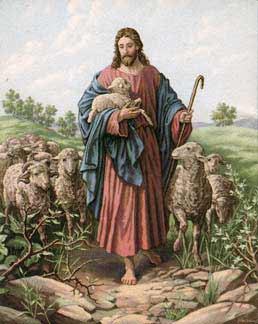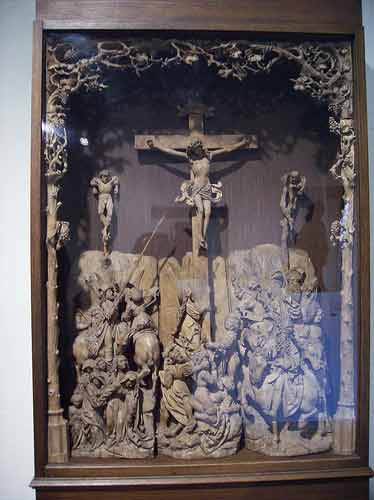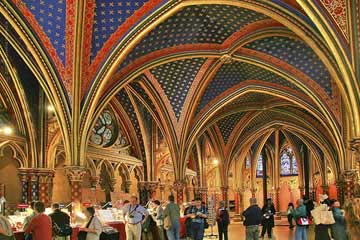|
When I was a lad on the farm, we went to Lutheran Sunday School every week, where we learned all the bible stories suitable for children (we had to read the others, such as the story of David and Bathsheba, on our own). One Christmas, when I was about 8, our Sunday School teacher gave each of us a glow-in-the-dark inspirational picture on cardboard backing. Mine showed Jesus as a shepherd, and my parents hung it in my bedroom, perhaps thinking it would comfort me if I awoke in the middle of the night to see a ghostly monotone greenish-white Jesus and his greenish-white sheep. The picture actually lost all its flouresence within a couple of hours after sunset, so if I awoke at, say, midnight, Jesus and the sheep were gone. I don't know if the publisher had thought about the spiritual implications of a Savior who can't even last the night. The picture gradually lost all its flouresence, and when I was about 10, we used it as kindling for the cookstove. I hadn't thought about it again, until the other day, when I remembered it and wondered if my memories were accurate.
Ah, the magic of the Internet. In my own home, and without any effort, I recovered the long-lost allegorical picture of Jesus as a shepherd. The drab colors are about the way I remember them, but I found no image that matched the one that's burned into my mind: the ghostly glow of Jesus and his flock after the sun went down. We had two pet sheep back then, so you'd think I would have related to the allegory better. Now that I re-examine the picture, I see why it didn't affect me much. The picture is luminous, but not numinous. The implicit message, that one should put complete trust in Jesus, is too simple to be useful in real life. Even back then (thanks to Sunday School), I understood the analogy, but I also had no illusions about even a flourescent Jesus protecting me through the night. If, after a stiflingly sultry day, a bad storm that could become a tornado came up at night, we did not pray to Jesus. Instead, Dad would wake us, light a lantern, and all of us would run to the storm cellar, which was about 100 feet from the house. I remember some windy nights when we had to dodge falling limbs. Any thought of a peaceful Jesus with his sheep was far away. That same summer, our two pet sheep were murdered in the middle of the night by a neighbor's dog who was out on a killing spree. I've looked at a lot of art over the years. Images based on non-pictorial ideas, such as the Jesus as a shepherd analogy, leave me cold, as do those that are thought out too carefully. The images that connect spiritually with me are the ones that indicate that the artist was a maniac, or at least not influenced by the same concepts that the rest of us live by. The spirituality that affects me grows out of aesthetics, not ideas.
We've only visited The Cloisters in New York City once, over 40 years ago, but I remember parts of it very well. I particularly remember an unusual wood carving of the crucifixion, a retable attributed to an early-16th-century German named Hans Wydytz. The ideas one gets from the carving seem to grow out of the image, rather than having been imposed by the artist. The lower scene is all chaos: rearing horses, soldiers, grieving disciples. Someone, (Mary?) is trying unsuccessfully to climb the pole, either to save Jesus or to join him. The sky overhead is hidden by thorny trees, indicating that Jesus isn't going to get to heaven until he's spent 3 days in hell. But Jesus on the cross is all serenity, far removed from the chaos below. The two thieves being hung with him are slightly lower, forming a triangular area at the top. The triangle motif is enhanced by one of the soldiers, who is thrusting a spear at Jesus to wound him. In addition to wounding, the spear forms another triangle serving to point out the main theme of the carving. There's no overt comfort in it, but I found it comforting nonetheless. 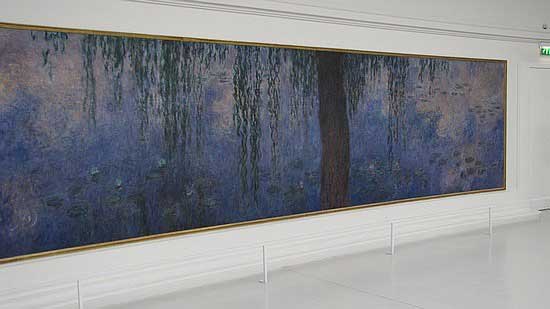 MONET'S WATER LILIES -- ORANGERIE, PARIS Part of spirituality for me is a feeling of being overwhelmed, so I find it easier to feel a spiritual connection with a work of art if I'm surrounded by it. I got such a feeling at the Orangerie in Paris on a Sunday morning, in a roomful of giant paintings by Monet of his water lilies. These paintings are about the triumph of water, a sort of visual baptism. I read a scholar once who wrote that Monet's later paintings were affected by his failing eyesight. I refuse to believe that such spiritually overwhelming art could be the result of failing faculties. I prefer to think that his acuity was sharpened in his old age.
Notre Dame left me strangely unaffected, perhaps because I've
seen so many pictures of it, but we accidentally stumbled on a real gem
in Paris: Sainte Chapelle. We'd never heard of it, but were walking by
on our way to somewhere else, and decided to stop in. Pictures on the
internet don't do justice to the incredible stained-glass windows, but
this picture gives some idea of the architecture. I found it strange
that such precise geometric patterns could arouse such a feeling of awe
in me. This isn't a collection of my top 10 spiritual works of art (there are only 5 shown here), but somewhere near the top has to be the Rothko Chapel, located in a park in (of all places) Houston, Texas. It's very quiet, removed from the chaos of Houston, and no one else was there when we visited it. You sit on one of the benches, surrounded by Rothko paintings. Each one is almost solid color, and the purplish-black hue varies only slightly from picture to picture. 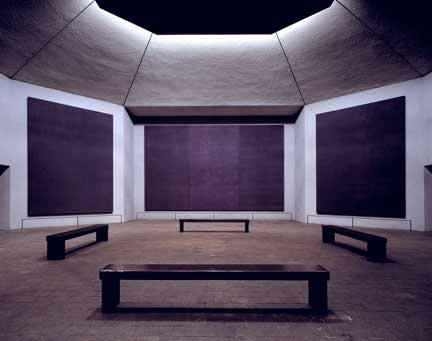 ROTHKO CHAPEL -- HOUSTON, TEXAS It seems to me a paradox that the most minimalist experience should also be the most spiritually powerful, but I suppose that, if I ever get to the famous Zen garden in Kyoto, I'll have the same experience. Meanwhile, I'll have to be satisfied with the most spiritual spot in Minneapolis, which, paradoxically, is maximalist: the Eloise Butler Wild Flower Garden, which, unlike the Kyoto garden, is exuberant and overflowing with green life. It's carefully tended to look as if it's not tended. Spring is in the air, and I can't wait for all the wild green things to reappear, the trillium and the ferns, my kind of resurrection. |
RETURN TO LOFGREN HOME PAGE
